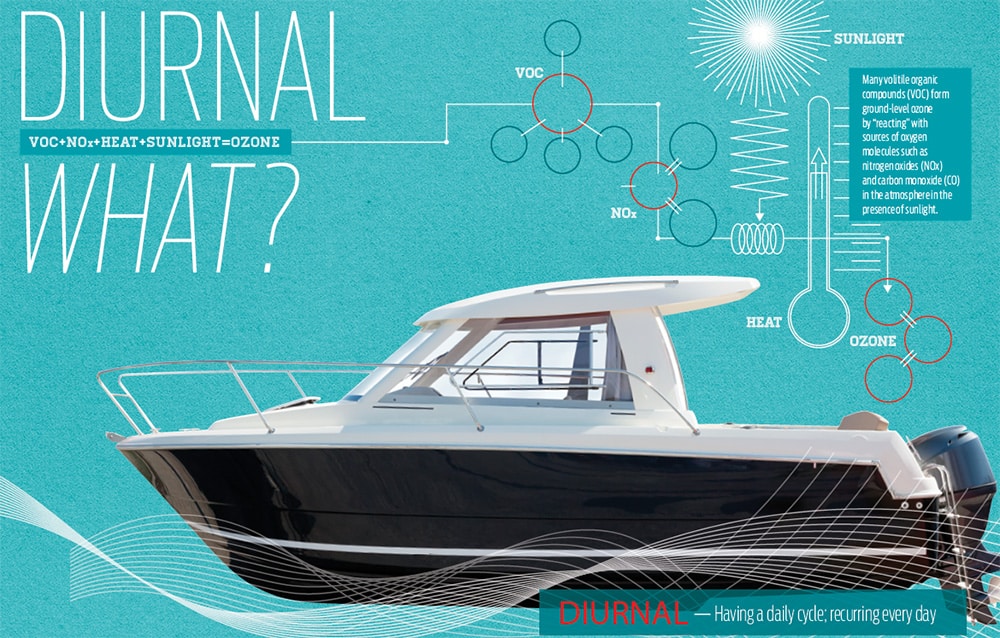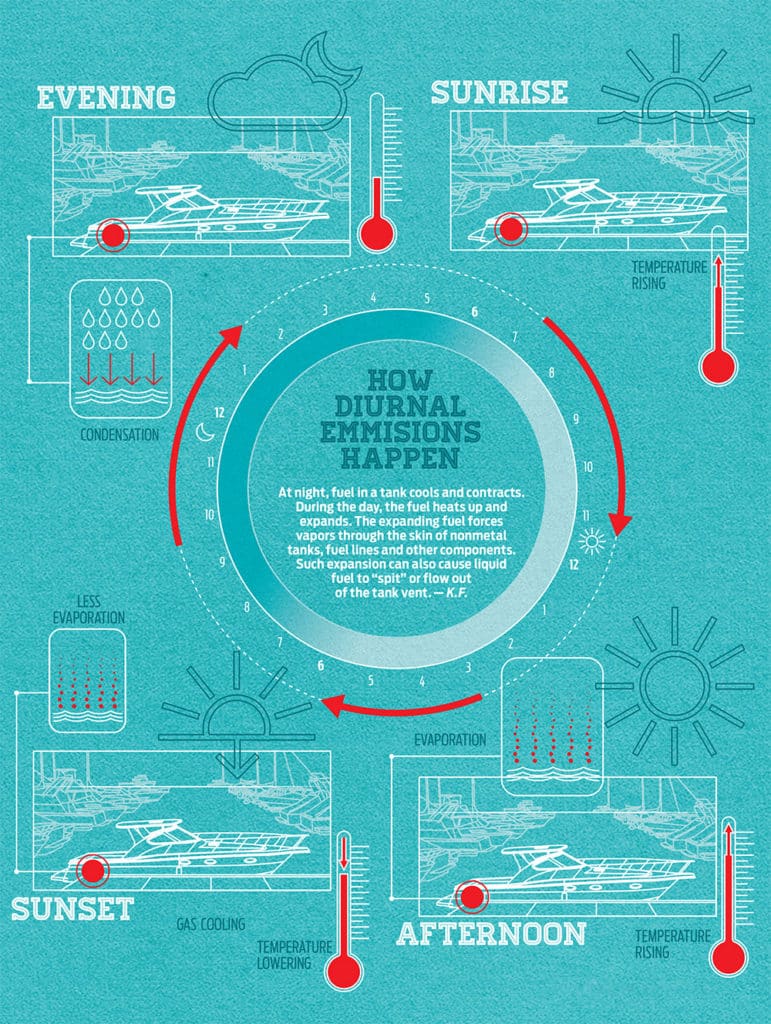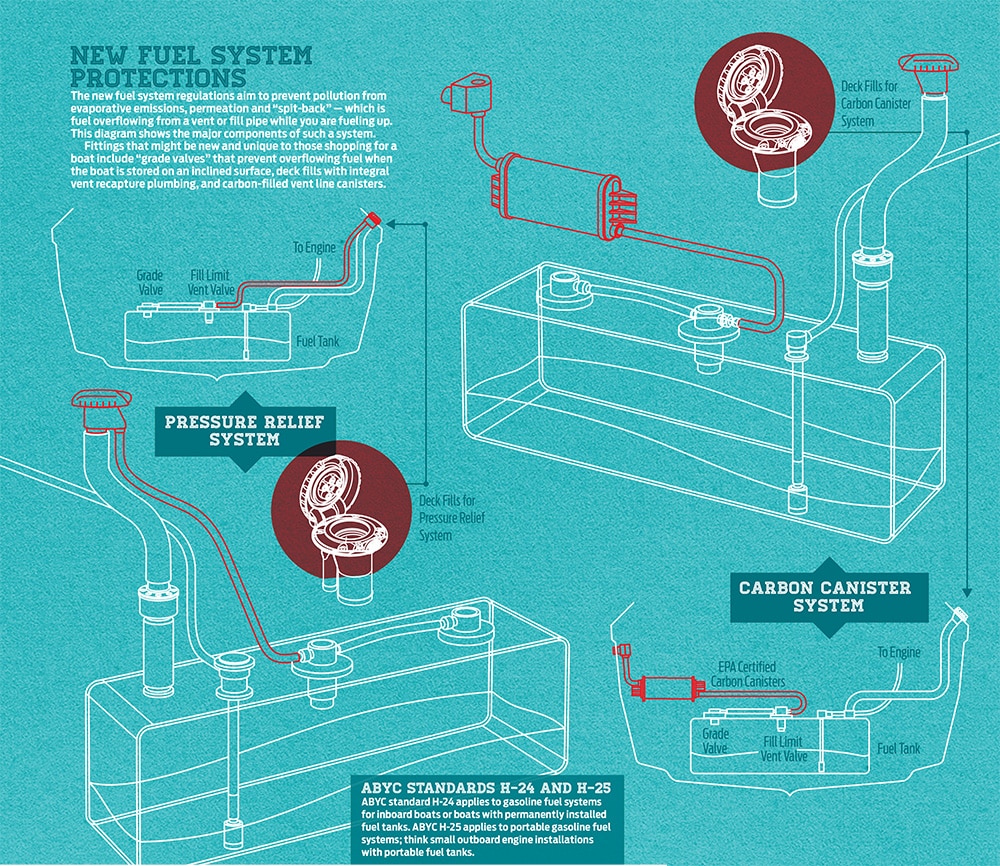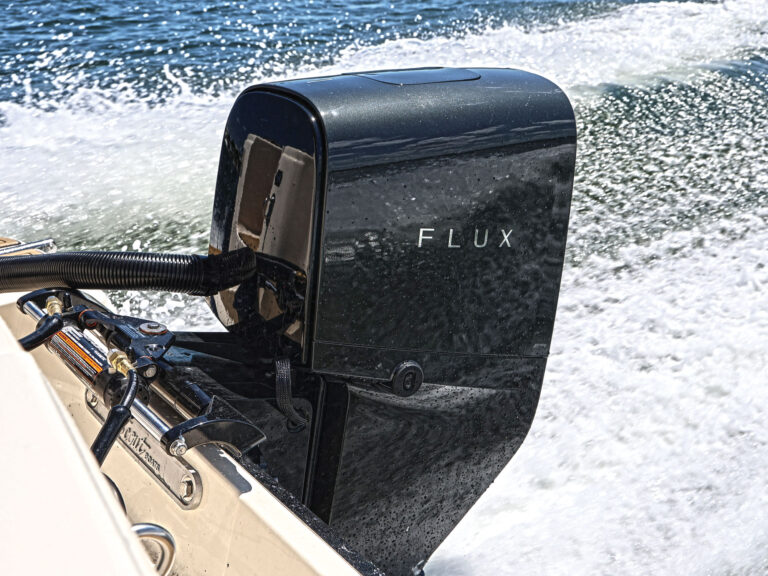
Fuel System Safety Tips
Your first question might be what the heck is diurnal? We’re talking about fuel evaporative emissions that occur as a result of venting fuel-tank vapors during daily temperature changes while the engine is not even running. Emissions, yes; not engine exhaust. Evaporative emissions permeate fuel lines, fuel vents, plastic fuel tanks and outboard engine primer bulbs.
How will the new requirements change my old boat? What changes have they wrought for new boats? What are the potential problems and solutions that we know about already? What new maintenance requirements are there with these new fuel systems?
I’ll answer all of these questions here.
Older Boats
You aren’t going to have to do much of anything with your existing boat until you need to replace fuel lines. There has been a gradual phase-in of requirements since 2009, and it began with the introduction of less permeable fuel hose. The hose used aboard older boats has an engineered permeation rate maximum of either 100 or 300 grams per square meter (for those challenged by the metric system, that’s about 3.5 or 11 ounces for every 11 square feet) for a 24-hour time cycle. The 100-gram value would apply to all the fuel distribution lines that may be under pressure on the boat, say between the fuel pump and carburetor, in the fuel-injection system, or under suction from the tank to the fuel pump. The 300-gram hose would be acceptable for fuel-fill and vent hoses that are not normally filled with fuel, so permeation is less of a concern.
The new requirements call for hose with a maximum permeation rate of 15 grams per square meter (about a half-ounce for every 11 square feet) over a 24-hour period, a significant reduction. So, any hoses from the fuel tank to the engine that you replace on your older boat will need to meet the new requirement. The other part of this that doesn’t get talked about too much is that there has always been a requirement in place that demanded a complete fuel-system inspection at least annually. The reality is that many boaters never inspect their fuel systems until someone smells gasoline! Bad choice.
Outboard fuel hoses and primer bulbs are exposed to the sun’s ultraviolet light rays, dictating that these parts get replaced on a regular basis. With inboards, hoses out of sight are out of mind. When you replace, look for hose marked U.S. Coast Guard A-1-15. The “A” denotes fire-rated hose, and the number 15 is the permeation rate designator. Hose types sometimes used outside engine room areas will have a “B” letter designator, which indicates the hose is not rated as fire tested. Type B fuel hose should never be used in inboard engine room areas because of the lack of fire-test rating. How long should you expect your boat’s fuel system components to last? The EPA defines useful life as 10 years for boat fuel system components and five years for PWC fuel systems.

Fuel System Safety Tips
New Boats
Beginning in 2009 for California and in 2011 for the rest of the United States, portable fuel tank makers and PWC manufacturers had to meet diurnal emissions requirements. For the portable fuel tank, this basically meant using new multilayer plastic formulas to reduce the fuel vapor permeability rate for the tank as well as re-engineering fill cap and vent setups on the tanks to reduce the potential for any leakage. All new tanks available in the marketplace today will meet these new requirements.
Fuel hoses and primer bulbs have also been re-engineered to meet the new requirements for lower permeability. One important note in this area is that most of the hose available with pre-fitted primer bulbs is B-1-15 rated, meaning that it is not fire rated and therefore should not be used in engine compartment applications as we sometimes see. PWC manufacturers have to employ similar strategies in their fuel delivery and storage system designs.
As for boats, either inboard or outboard powered with built-in fuel tanks, the new fuel systems not only need to control evaporative emissions, but they also need to integrate components to control fuel spit-back associated with refueling and to ensure that fuel can’t escape via the tank vent system when the boat is fueled or stored on an incline. Methods used to meet these needs will vary from one manufacturer to another, but all of the available systems will employ various safety and check valves to control such things as automatic fuel-fill shut-off points to prevent overfilling, pressure relief points, and fuel-fill inlet and grade valves to manage fuel levels on hills and prevent overflowing fuel from contaminating other system components, such as carbon canisters. As for maintenance of these components, Attwood Corp., a major supplier of these system components to boatbuilders, claims that its systems are engineered for lifetime performance and elimination of maintenance requirements. Other original-equipment-manufacturer suppliers describe their components as having qualities comparable to those in automotive applications, where today problems with the systems are extremely rare.
As for fuel tanks, builders have some options. Traditional aluminum tanks are one option and will require only modification to facilitate the mounting of some needed valves. Permeability is not a concern here because the metal is considered impermeable. Any gaskets used to seal such items as level gauge senders and the various system valves must, of course, be appropriate to ensure they don’t leak, but aside from that, metal tanks are as good a choice as ever.
I had a chance to inspect some samples of new plastic tanks that are certified to meet EPA requirements at a recent industry trade show. Moeller Marine Products, for example, had its tanks on display and described its plastic tanks as “bi-layer” plastic, with the inner layer being made of nylon. Moeller said these tanks are fully compatible with ethanol fuels and that they reduce permeability. Other tank cutaways I inspected appeared to have an epoxy layer painted over the interior plastic surfaces to reduce their permeability levels. So, the bottom line here is that a new boat owner is really not going to notice any difference whatsoever on the fuel tank side of things. All of the new systems employ valves to eliminate the historic problem of fuel spilling out of the tank vent when a tank nears its full capacity.

Fuel System Safety Tips
Noticeable Differences
On my own 2012 outboard-powered center-console, I’ve inspected the entire fuel system in the year I’ve owned it. It has an aluminum fuel tank and a latching fuel-fill cap. Aside from that, about the only noticeable differences are some small air bleed vents located on the inside of the fuel-fill cap and the presence of a carbon canister under one of the seats in the transom of the boat. I haven’t seen any fuel spitting out from my tank vent and, in fact, can’t even smell any gasoline vapors from the vent, telling me the charcoal is doing its job. The auto fuel shut-off feature at fuel docks seems to work just fine. So far, so good. I did manage to get a trouble-symptoms list from one of the systems designers who was willing to discuss some of the things engineers discovered as they were developing and testing their own product line. It’s a short list and good information in case your new boat does start showing any of these symptoms.
Trouble Symptoms: New Tank Effect
The first fill-up of a new tank may cause the system to vapor-lock and shut off the fuel nozzle. If that happens, wait 10 minutes for fuel vapors to penetrate the whole system. Following that, this glitch should not reoccur.
If the problem does not go away, the vent hose may be pinched or kinked. This can cause excess tank pressure to build up, shutting the safety valves in play and halting fuel flow. It could be caused by incorrect placement of the fuel-fill-limit valve by the builder, or by hoses that are too long so that they develop a kink or a low point where liquid fuel will accumulate and restrict ventilating capability. Fuel flow from the fill nozzle could also be restricted by a clogged charcoal canister. The bottom line here is that such problems need to be handled by the boat dealer. If the problem is related to installation, it represents a genuine warranty issue.
One thing you don’t want to do is try to get the evaporative control system bypassed or removed, or try to do that yourself. Remember too that all of the components for these systems need to be certified by the EPA and substitution with improper hoses, valves and canisters could end up causing more problems than you’ll be minimizing.
So what’s the bottom line with the new evaporative emissions control systems on boats? Well, based on two seasons of use on my own boat and the feelings of the systems design engineers I’ve spoken with, you’ll never know the system is on your boat. I think it’s safe to say that you can expect years of trouble-free service from these systems.
Fuel System Safety Tips
*Inspect fuel system at least annually.
*Never use B-rated fuel hose inside an engine compartment.
*Only A-rated hoses are fire rated.








